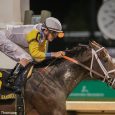Seventeen.
It was the age I got my driver’s license. For some girls, it is a magazine that offers them advice on becoming a woman. The great Bob Gibson set this record when he struck out this many Tigers in Game One of the 1968 World Series; he played the same number of seasons for the St. Louis Cardinals. Chris Mullin wore this number, which is now retired with the Golden State Warriors.
Seventeen.
It is also the only post position in the Kentucky Derby (G1) to never produce a winner.

Looking at a chart of wins by post position for all the Kentucky Derby races that have run from a starting gate from 1930 to present, we see that not only has a horse starting from post position 17 not won a race in 39 tries, it is also tied with post position 19 for the lowest percentage of starters finishing in the money (7.69%).

Based on the odds of the 39 previous horses that started out of post 17, the expected result is at least three winners. The only two heavy favorites on the list, Arazi in 1992 and Point Given in 2001, finished out of the money.

If you discount the inflated odds of horses that were in the “field” or not the primary selection of a coupled entry, you’d be left with 28 horses that should result in at least two winners. (Prior to 2001, betting interests numbered 14 and higher were coupled together as a single betting interest called the “field”).
So why does post 17 do so poorly?
Large Fields Equals a Higher Probability of Troubled Trips
Since 1999, the field size of the Kentucky Derby has averaged 19 starters. With this many horses breaking at once, you are bound to have some troubled trips. In the 2017 Kentucky Derby, 12 of the 20 entrants showed some sort of trouble in their final running lines. On average, in the larger Kentucky Derby fields, about half of the entrants will encounter some sort of trouble during the race.
Perhaps the horses breaking from the first stall of the auxiliary gate (post 15) get some relief since there is a gap between them and the last stall of the normal gate? When you watch the head on footage of the break from the gate every year, those auxiliary gate horses usually start out heading left toward the rail. It is hard for any horse to not get tangled up with this type of start.
Number of High-Odds Horses
Post position 17 has only boasted two favorites out of 39 starters and only six horses that went off at odds under 5-1 (excluding field bets and the non-favored part of a coupled entry). With stats like that and the best three year olds in the country running, it is hard, yet not impossible, for a 50-1 horse to find the Winners’ Circle. If you exclude the horses with high odds, post 17 should have had at least one winner.
Small Sample Size
In a game where angles, trends, figures, and track biases are created on a lot of data, the modern Kentucky Derby is a small subset of data. The outer posts are even smaller sets of data. Over time you would expect the data to normalize, but with this few data points, you are subject to more anomalies.
Is all hope lost for post 17?
No. It wasn’t until recently that posts 16, 19, and 20 notched a victory. Post position 16 finally got a win in 1995 with Thunder Gulch, then three more shortly thereafter: Charismatic (‘99), Monarchos (‘01), and Animal Kingdom (‘11). Post position 19 was a winner in 2012 with I’ll Have Another. Post position 20 found the Winners’ Circle with Big Brown in 2008.
Will 2018 finally be the year that a horse starting from post 17 finally scores a win, or will the supposed “curse” of post position 17 endure longer than the “Curse of Apollo”? We’ll find out soon enough!




